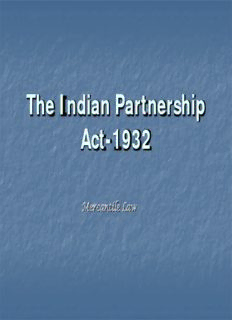
The Indian Partnership Act-1932 PDF
Preview The Indian Partnership Act-1932
The Indian Partnership Act-1932 Mercantile Law What is Partnership ? Partnership is the relation between persons who have agreed to share the profits of a business carried on by all or any one of them acting for all (Section 4). It, therefore, follows that a partnership consists of three essential elements: What is Partnership ? (i) It must be a result of an agreement between two or more persons. (ii) The agreement must be to share the profits of the business. (iii)The business must be carried on by all or any of them acting for all. All these essentials must coexist before a partnership can come into existence. Essential Elements of Partnership (1)Agreement: Partnership must be the result of an agreement between two or more persons.An agreement from which relationship of Partnership arises may be express. It may also be implied from the act done by partners and from a consistent course of conduct being followed, showing mutual understanding between them. It may be oral or in writing. Mercantile Law: The Indian 4 Partnership Act,1932 Essential Elements of Partnership(Cont..) (2) Sharing profits of the business: First, there must exist a business i.e. trade, occupation and profession. The motive of the business is the acquisition of gains.Therefore there can be no partnership where there is no intention to carry on the business and to share the profit thereof. Mercantile Law: The Indian 5 Partnership Act,1932 Essential Elements of Partnership(Cont..) Secondly, there must be an agreement to share profits. The agreement to share losses is not an essential element. However in the event of losses, unless agreed otherwise, these must be born in the profit sharing ratio. Mercantile Law: The Indian 6 Partnership Act,1932 Essential Elements of Partnership(Cont..) (3)Business carried on by all or any of them acting for all: Each partner carries on the business as a principle as well as the agent on behalf of the other partners. This is the cardinal principle of the partnership Law. Therefore, the true test of partnership is mutual agency rather than sharing of profits. Mercantile Law: The Indian 7 Partnership Act,1932 True test of Partnership The sharing of profits or of gross returns accruing from property by persons holding joint or common interest in the property would not by itself make such persons partners. Although the right to participate in profits is a strong test of partnership, and there may be cases where, upon a simple participation in profits, there is a partnership, yet whether the relation does or does not exist must depend upon the whole contract between the parties. Mercantile Law: The Indian 8 Partnership Act,1932 True test of Partnership(Cont..) But the task becomes difficult when either there is no specific agreement or the agreement is such as does not specially speak of partnership. In such a case for testing the existence or otherwise of partnership relation, Section 6 has to be referred. According to this Section, regard must be had to the real relation between the parties as shown by all relevant facts taken together. Mercantile Law: The Indian 9 Partnership Act,1932 Distinction between partnership and firm Persons who have entered into partnership with one another are called individual “Partners” and “collectively” and the name under which the business is carried on is called “firm name”. Partnership is merely an abstract legal relation between the partners. A firm is a concrete thing signifying the collective entity for all the partners. Partnership is thus that invisibility which binds the partners together and firm is the visible form of those partners who are thus bound together. Mercantile Law: The Indian 10 Partnership Act,1932
Description: